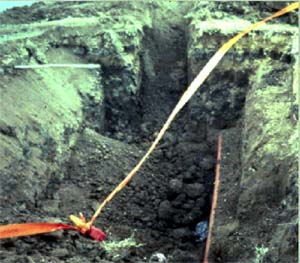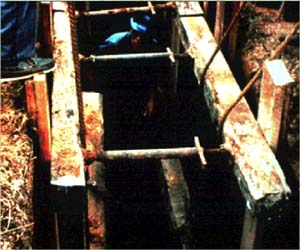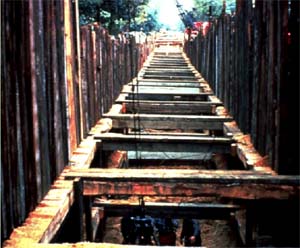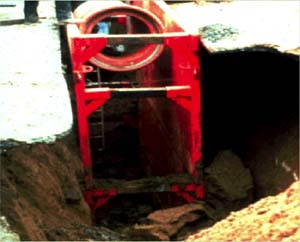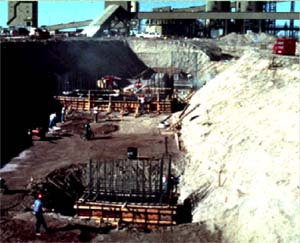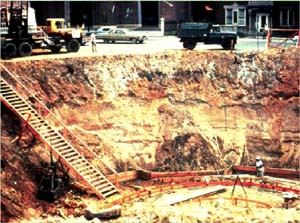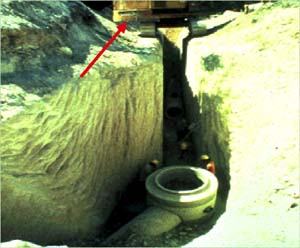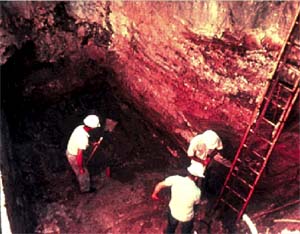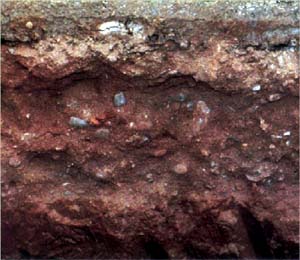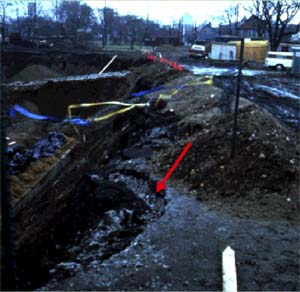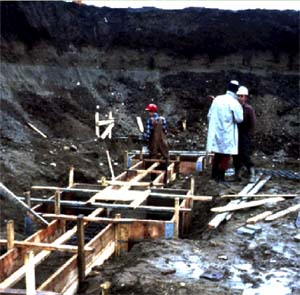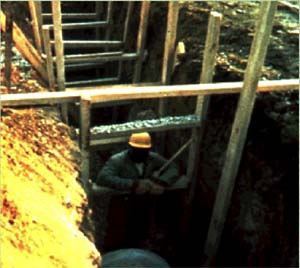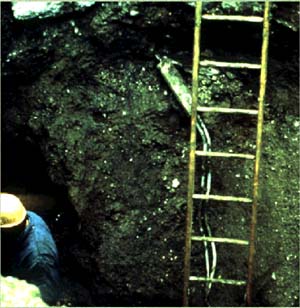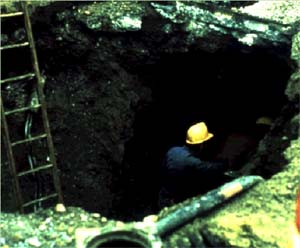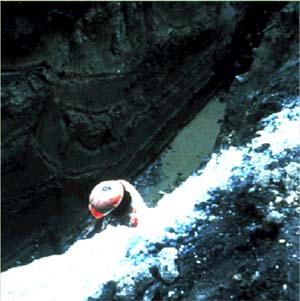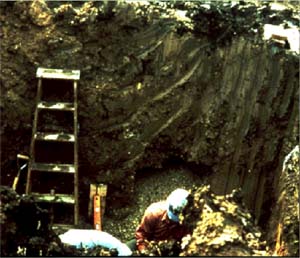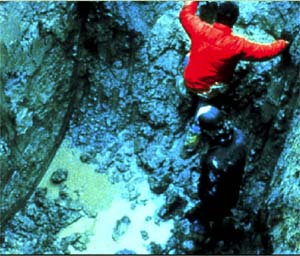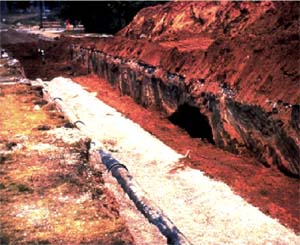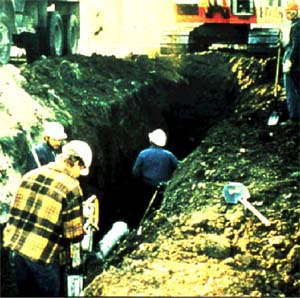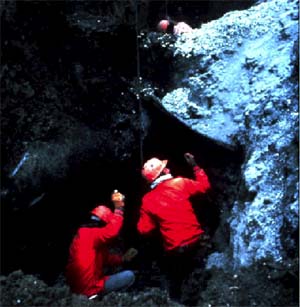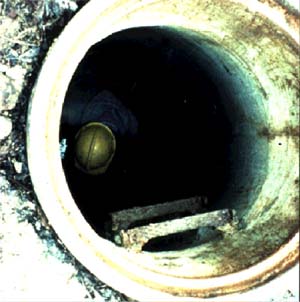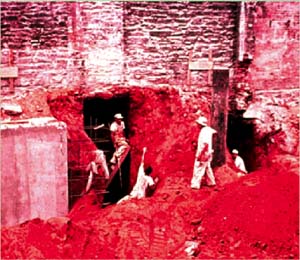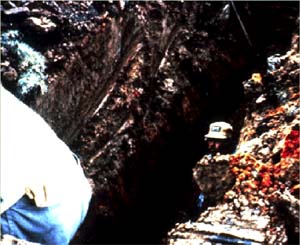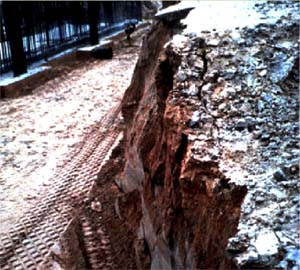Summary Statement
A presentation on the excavation standard, overview of soil mechanics and recognition of excavation hazards. Part of a collection.
June 3, 1996
| These materials were produced by the Division of Safety, Florida Department of Labor and Employment Security, as part of a special OSHA program to reduce work-related deaths in construction in California, Florida, and Texas. Because Florida's funding for the program - CARE, or Construction Accident Reduction Emphasis - ended in June 2000, the materials will not be updated. The materials should be reviewed yearly for any needed changes. |
Objectives
To provide
students with:
- An introduction to 29 CFR 1926,
- Subpart P-Excavation Standard
- An overview of soil mechanics
- An introduction to trenching and excavation hazard recognition
29 CFR 1926, Subpart P
1926.650
- Scope, application,
and definitions applicable to this subpart
- General requirements
- Requirements for protective systems
1926.650 Scope, Application,
and Definitions
- Scope and application
- Definitions
- Competent Person
- Accepted engineering
practices
- Aluminum hydraulic
shoring
- Bell- bottom pier
- Benching
- Cave- in
- Competent person
- Cross braces
- Kick- out
- Protective systems
- Ramp
- Registered professional
engineer
- Sheeting
- Shield
- Shoring
- Excavation
- Faces or sides
- Failure
- Hazardous atmospheres`
- Sloping
- Stable rock
- Structural ramp
- Trench.
Definitions
"Excavation" means any:
- Man- made cut
- Cavity
- Trench
- Depression in an earth surface, formed by earth removal.
.Confined space is
a space that, by design and/ or configuration has:
- Limited openings
for entry and exit
- Unfavorable natural
ventilation
- May contain or
produce hazardous substances
- Is not intended for continuous employee occupancy.
"Trench (Trench
excavation)" means a narrow excavation (in relation to its length)
made below the surface of the ground.
- In general, the
depth is greater than the width, but the width of a trench (measured
at the bottom) is not greater than 15 feet (4.6 m).

- If forms or other structures are installed or constructed in an excavation so as to reduce the dimension measured from the forms or structure to the side of the excavation to 15 feet (4.6 m) or less (measured at the bottom of the excavation), the excavation is also considered to be a trench.

Accepted
engineering practices are procedures that are compatible with the standard
practice required of a registered professional engineer.
.Adjacent structure stability refers to the stability of the foundation(
s) of adjacent structures whose location may create surcharges, changes
in soil conditions, or other disruptions that have the potential to extend
into the failure of the excavation or trench.
A competent persons is one who is capable of identifying existing and predictable hazards in the surroundings, or working conditions which are unsanitary, hazardous, or dangerous to employees, and who has authorization to eliminate them.
A competent
person must have specific training in, and be knowledgeable about,
- soils analysis
- the use of protective
systems
- requirements of this standard
Protective systems
refers to a method of protecting employees from cave- ins, material that
could fall or roll from an excavation face into an excavation, and from
the collapse of adjacent structures.
.
Protective systems include support systems, sloping and benching systems,
shield systems, and other systems that provide the necessary protection.




1926.651 - General requirements
- Surface encumbrances
- Underground installations
- Access and egress
- Exposure to vehicular
traffic
- Exposure to falling
loads
- Warning system
for mobile equipment
- Stability of adjacent
structures
- Protection of
employees from loose rock or soil
- Inspections
- Fall protection
- Hazardous atmospheres
- Protection from hazards associated with water accumulation
1926.651( c)( 2) Means of
egress
.
Means of egress from
trench excavations: .
- A stairway, ladder, ramp or other safe means of egress shall be located in trench excavations that are 4 feet (1.22 mm) or more in depth.
- A means of egress should require no more than 25 feet (7.62 m) of lateral travel for any employee to reach.
1926.651( k)- Inspections
Daily inspections
of excavations, the adjacent areas, and protective systems shall be made
by a competent person for evidence of a situation that could result in:
- Possible cave- ins
- Indications of failure of protective systems
- Hazardous atmospheres
- Other hazardous conditions.
An inspection shall
be conducted by the competent person:
- Prior to the start of work and as needed throughout the shift.
- After every rainstorm or other hazard increasing occurrence.
- These inspections are only required when employee exposure can be reasonably anticipated.
1926.652 - Requirements
for protective systems
- Protection of
employees in excavations
- Design of sloping
and benching systems
- Design of support
systems, shield systems, and other protective systems
- Materials and
equipment
- Installation and removal
1926.652 ( a)- Protection
of employees in excavations
.(1) Each employee
in an excavation shall be protected from cave- ins by an adequate protective
system designed in accordance with paragraph (b) or (c) of this section
except when:
- (i) Excavations
are made entirely in stable rock; or
- (ii) Excavations are less than 5 feet (1.52 m) in depth and examination of the ground by a competent person provides no indication of a potential cave- in.



1926.652 (d)-
Materials and equipment
.(1) Materials and
equipment used for protective systems shall be free from damage or defects
that might impair their proper function.
(3)
When material or equipment that is used for protective systems is damaged,
a competent
person shall examine the material or equipment and evaluate its suitability
for continued use.
If the
competent person cannot assure the material or equipment is able to support
the intended loads or is otherwise suitable for safe use.
- Such material or equipment shall be removed from service.
- Such material or equipment shall be evaluated and approved by a registered professional engineer before being returned to service.
Worker Protection Systems
Appendix A
- Soil Classification
- Sloping & Benching
- Timber Shoring
- Aluminum Hydraulic Shoring


Soil
Testing
OBJECTIVES
Provide
the student with:
- A brief overview
of 29 CFR 1926 Subpart P Excavation Standard
- A Brief Introduction
into Soil mechanics
- A Brief overview of tests they can use in determining soil conditions
Overview: Soil Mechanics
Soil Mechanics
A number of stresses and deformities can occur in an open cut or trench.
For example, increases
and decreases in moisture content can adversely affect the stability of
a trench or excavation.
Following are some of the more frequently identified causes of trench
failure.
Tension Cracks: Usually form at a horizontal distance of .5 to .75 times the depth of the trench, measured from the top of the vertical face of the trench.
Sliding or Sluffing: May occur as a result of tension cracks.

Toppling: In addition
to sliding, tension cracks can cause toppling.
- Toppling occurs when the trench’s vertical face shears along the tension crack line and topples into the excavation.

Subsidence and Bulging:
- An unsupported excavation can create unbalanced stress in the soil, which in turn, causes subsidence at the surface and bulging of the vertical face of the trench.
- If uncorrected, this condition can cause face failure and entrapment of workers in the trench.
Bottom heaving or squeezing is caused by the downward pressure created by the weight of adjoining soil. This pressure causes a bulge in the bottom of the cut.
Heaving and squeezing
can occur even when shoring or shielding has been properly installed.
Boiling is evidenced by an upward water flow into the bottom of the cut.
- A high water table is one cause of boiling.
Boiling produces a “quick” condition in the bottom of the cut, and occur even when shoring or trench boxes are used.

Soil
- Composition
What is Soil ?

Soils - Types
Gravel
- larger than 2 millimeters
- Smaller than 2 millimeters but larger than 0.075 millimeters
- Smaller than 0.075 millimeters but larger than 0.002 millimeters
- Smaller than 0.002 millimeters
Determination of Soil Type
OSHA categorizes soil
and rock deposits into four types. Each type is briefly described below.
Stable rock is natural solid mineral matter that can be excavated with vertical sides and remain intact while exposed.
Black Pine Mine
Slide - Idaho

Type A soils are cohesive
soils with an unconfined compressive strength of 1.5 tons per square foot
or greater.
Examples of type
A soils are: clay, silty clay, sandy clay, clay loam, and in some cases
silty clay loam and sandy clay loam.
No soil is type A if it is fissured, is subject to vibration of any type,
has previously been disturbed, is part of a sloped, layered system where
the layers dip into the excavation on a slope of 4H to 1V or greater,
or has seeping water.
Type B soils are cohesive soils with an unconfined compressive strength
greater than 0.5 tons per square foot, but less than 1.5 tons per square
foot.
Examples are: angular
gravel, silt, silt loam, previously disturbed soils unless otherwise classified
as type C soil.
Soils that meet the unconfined compressive strength or cementation requirements
of type A soils but are fissured or subject to vibration; dry unstable
rock; layered systems sloping into the trench at a slope less than 4H
to 1V ( only if the material would be classified as a type B soil).
Type C soils are cohesive soils with an unconfined compressive strength
of 0.5 tons per square foot or less and include granular soils such as
gravel, sand and loamy sand, submerged soil, soil from which water is
freely seeping, and submerged rock that is not stable.
Type C soils also include in this classification material in a sloped,
layered system where the layers dip into the excavation or have a slope
of 4H to 1V or greater.
|
|
|
 |
|
 |
= 167 lbs. |
 |
= 62.4 lbs |
|
Specific
Gravity
The ratio of the weight of an object, to the weight of an equal volume of water. |
Soils - Volume

Soils - Cubic
Yard Weight
 |
Average soil |
 |
Physical characteristics of sand and silt |
 |
Soil sample |
 |
Physical characteristics of clay |
Field Tests
- Documenting field
tests
- Sedimentation
- Ribbon
- Torvane
- Pocket Penetrometer
- Thumb imprint
Documenting Field Test
- All Tests
- Representative
sample
- Spoil pile
- Inside the
trench
- Diagram
- Site map
- Record reading
- Soil rating
- Representative
sample

| Soil Sample |
|
 Mix it - Quarter it |
 Mix it - Quarter it |
 Mix it - Quarter it |

 Test # 1 - Field Sedimentation
Test
Test # 1 - Field Sedimentation
Test
- Determines sand content
- Used only on sandy soils
- Sample taken from the spoil pile
- Representative of soil in the excavation
- Fill glass jar
- 5 inches of water on top of soil
- 1 1/2 inches of soil
- Flat bottom container - at least 7 inches high
|
|
 |


The Ribbon Test
- Run only on that part of the soil which passes # 40 sieve
- Test shows clay material
- Run on disturbed soil
- Representative sample from spoil pile
- Mix soil + water to make into plastic mass
- Roll mass into cylindrical shape 1/2 to 3/4 inch diameter
- Lay across palm of hand
- Press between thumb and second joint of index finger
- Pass through thumb
- Squeeze until it takes the shape of a 1/8 to 1/4 inch thick strip
- Allow to hang freely from hand
- Clay loam will barely ribbon and break easily
- Clay = relatively long ribbon 6 to 8 inches or more
- More clay = longer and stronger ribbon Silt has tendency to produce short ribbon with broken appearance
 |
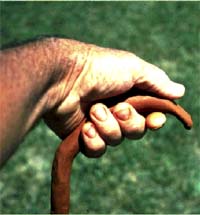 |
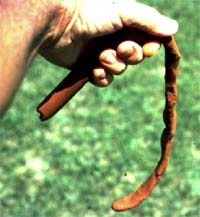 |
Penciling
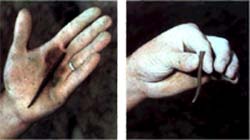
Test # 3 Torvane Shear Test
Torvane Shear
- Designed to be used on saturated cohesive clay soil
- Vanes are inserted into soil
- Twist and shear soil at base and around circumference of vanes
- Select fresh clod or block of undisturbed soil from spoil pile
- Cut a smooth surface on the clod
- Insert vanes of device into the soil
- Retract vanes to show foot imprint
- Set indicator at zero
- Hold device firmly against soil and twist in clockwise manner until soil fails in shear
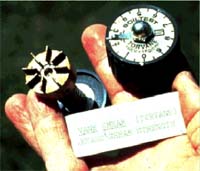 |
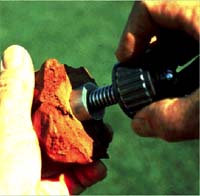 |
| Consistency Term | Shear Strength, psf | Unconfined Compressive Strength, psf | Soil Type |
| very soft |
<250
|
<500
|
Type C |
| soft |
250-500
|
500-1000
|
|
| medium |
500-1000
|
1000-2000
|
Type B |
| stiff stiff |
1000-1500
1500-2000 |
2000-3000
3000-4000 |
|
| very stiff |
2000-4000
|
4000-8000
|
Type A |
| hard |
>4000
|
>8000
|
Pocket Penetrometer
- Read the unconfined compressive strength at bottom of the red slip ring
- The reading may be 2.0 tons per square foot shear strength
- Which indicate the boundary between stiff and very stiff
- Device is designed to work on saturated clay soil
- Measures unconfined compressive strength of soil
- Twice the value of shear strength of same soil
- Note machine ring about a quarter of an inch
- Push red ring on the barrel all the way toward the handle
- Push shaft into the soil up to the red ring
- Hold barrel so as to not to interfere with the spring inside the barrel
- NOTE slip ring moved on the barrel as barrel was pushed back into the handle
 |
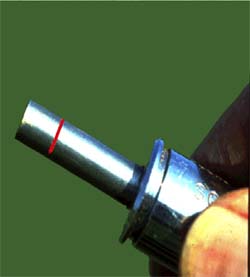 |
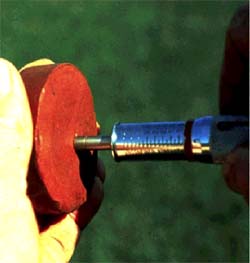 |
| Consistency Term | Shear Strength, psf | Unconfined Compressive Strength, psf | Soil Type |
| very soft |
<250
|
<500
|
Type C |
| soft |
250-500
|
500-1000
|
|
| medium |
500-1000
|
1000-2000
|
Type B |
| stiff stiff |
1000-1500
1500-2000 |
2000-3000
3000-4000 |
|
| very stiff |
2000-4000
|
4000-8000
|
Type A |
| hard |
>4000
|
>8000
|
Hazard Recognition Slides
